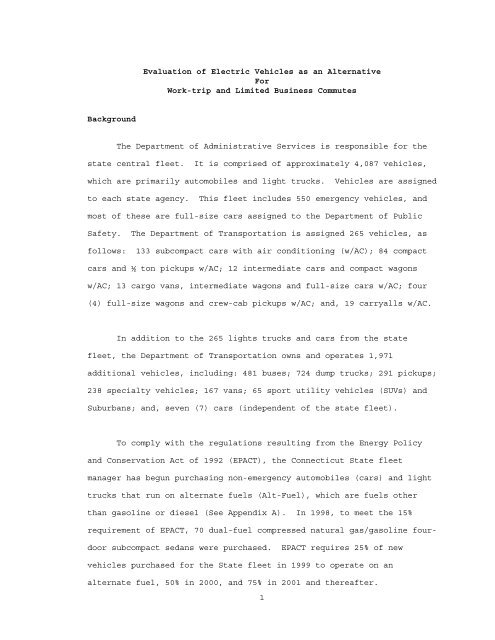Evaluation of Electric Vehicles as an Alternative for Work Trip and ...
Evaluation of Electric Vehicles as an Alternative for Work Trip and ...
Evaluation of Electric Vehicles as an Alternative for Work Trip and ...
Create successful ePaper yourself
Turn your PDF publications into a flip-book with our unique Google optimized e-Paper software.
Background<br />
<strong>Evaluation</strong> <strong>of</strong> <strong>Electric</strong> <strong>Vehicles</strong> <strong>as</strong> <strong>an</strong> <strong>Alternative</strong><br />
For<br />
<strong>Work</strong>-trip <strong>an</strong>d Limited Business Commutes<br />
The Department <strong>of</strong> Administrative Services is responsible <strong>for</strong> the<br />
state central fleet. It is comprised <strong>of</strong> approximately 4,087 vehicles,<br />
which are primarily automobiles <strong>an</strong>d light trucks. <strong>Vehicles</strong> are <strong>as</strong>signed<br />
to each state agency. This fleet includes 550 emergency vehicles, <strong>an</strong>d<br />
most <strong>of</strong> these are full-size cars <strong>as</strong>signed to the Department <strong>of</strong> Public<br />
Safety. The Department <strong>of</strong> Tr<strong>an</strong>sportation is <strong>as</strong>signed 265 vehicles, <strong>as</strong><br />
follows: 133 subcompact cars with air conditioning (w/AC); 84 compact<br />
cars <strong>an</strong>d ½ ton pickups w/AC; 12 intermediate cars <strong>an</strong>d compact wagons<br />
w/AC; 13 cargo v<strong>an</strong>s, intermediate wagons <strong>an</strong>d full-size cars w/AC; four<br />
(4) full-size wagons <strong>an</strong>d crew-cab pickups w/AC; <strong>an</strong>d, 19 carryalls w/AC.<br />
In addition to the 265 lights trucks <strong>an</strong>d cars from the state<br />
fleet, the Department <strong>of</strong> Tr<strong>an</strong>sportation owns <strong>an</strong>d operates 1,971<br />
additional vehicles, including: 481 buses; 724 dump trucks; 291 pickups;<br />
238 specialty vehicles; 167 v<strong>an</strong>s; 65 sport utility vehicles (SUVs) <strong>an</strong>d<br />
Suburb<strong>an</strong>s; <strong>an</strong>d, seven (7) cars (independent <strong>of</strong> the state fleet).<br />
To comply with the regulations resulting from the Energy Policy<br />
<strong>an</strong>d Conservation Act <strong>of</strong> 1992 (EPACT), the Connecticut State fleet<br />
m<strong>an</strong>ager h<strong>as</strong> begun purch<strong>as</strong>ing non-emergency automobiles (cars) <strong>an</strong>d light<br />
trucks that run on alternate fuels (Alt-Fuel), which are fuels other<br />
th<strong>an</strong> g<strong>as</strong>oline or diesel (See Appendix A). In 1998, to meet the 15%<br />
requirement <strong>of</strong> EPACT, 70 dual-fuel compressed natural g<strong>as</strong>/g<strong>as</strong>oline four-<br />
door subcompact sed<strong>an</strong>s were purch<strong>as</strong>ed. EPACT requires 25% <strong>of</strong> new<br />
vehicles purch<strong>as</strong>ed <strong>for</strong> the State fleet in 1999 to operate on <strong>an</strong><br />
alternate fuel, 50% in 2000, <strong>an</strong>d 75% in 2001 <strong>an</strong>d thereafter.<br />
1
















